2008 Visit
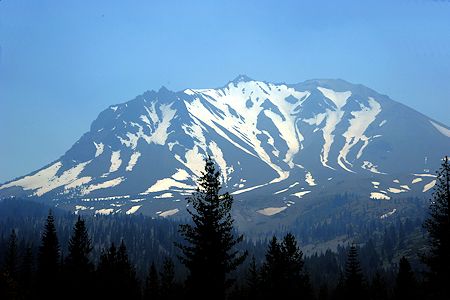
Lassen Peak from near the Devastated Area with some haze from forest fires
On June 23, 2008, while returning from Eugene, Oregon where I had taken Andrew Cole to spend the summer with his dad and grandmother, I decided to take a tour of Lassen National Park which I had not been to since 1975.
There were a large number of forest fires burning all over California including one in the northeast area of the Park so it was a bit smokey.
I walked the interpretive trail in the "Devastated Area" where I met a couple and their daughter from Southern California who had driven north for a vacation and to get away from the smoke. Unfortunately the nearby fire messed that up .. plus the fire had caused the electric power at their campground to go out.
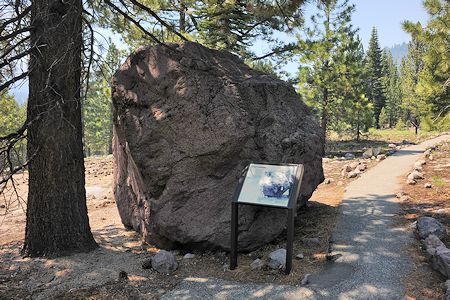
Old Giants This giant boulder is lava rock -- red dacite -- formed 27,000 years ago when Lassen Peak first erupted.
The boulder, along with other rocks in the area, was torn from the mountain and carried here some three miles below the summit by the avalanche that occurred following the May 19, 1915 eruption.
A Forest Gone Overnight the forest landscape changed, from a tranquil meadow-forest setting to a barren moon-like surface. Trees that once stood here were snapped, uprooted, and swept away by the avalanches and mudflows touched off during the May 19 and 22 eruptions.
These photographs, taken in 1910 and again in 1925, contrast dramatically with the destruction that occurred and the forest recovery that continues here today. The destruction was a mere moment, the recovery an evolution.
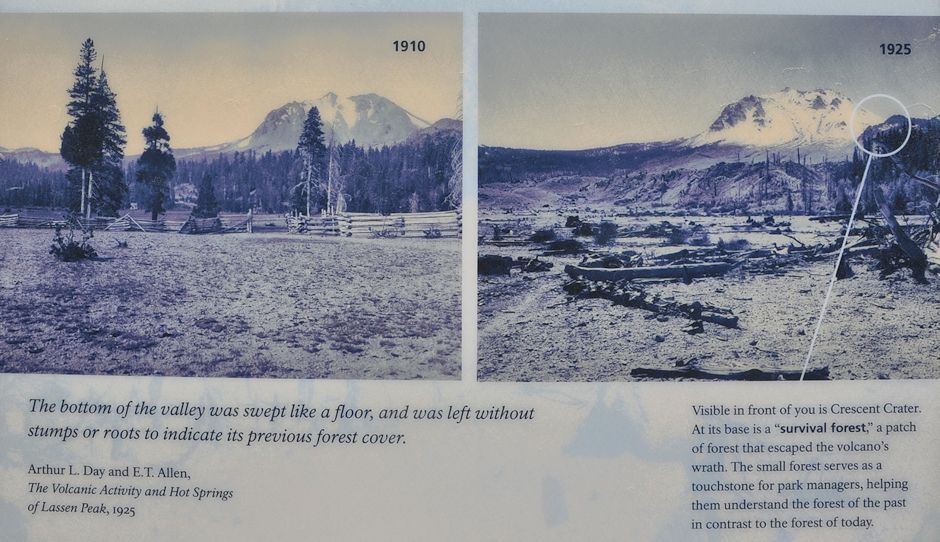
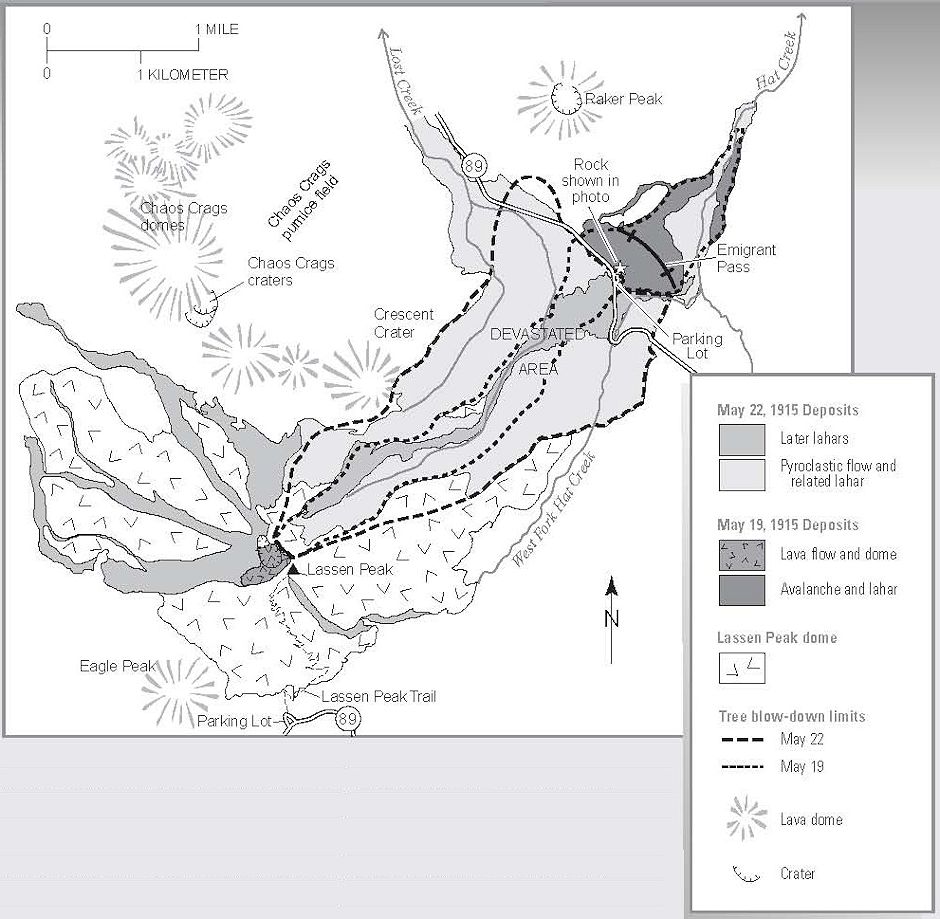
Map showing the "Devastated Area"
For complete information about volcanic activity at Lassen Peak read this USGS Fact Sheet Eruptions of Lassen Peak (588KB PDF file)
New Rocks, Old Rocks Although we generally think of rocks as thousands, millions, or even billions of years old, three of the five rock specimens displayed here are not yet a hundred years old. They are California's newest rocks, formed in 1915. The other two rocks are lava rock formed 27,000 years ago when Lassen Peak first erupted. Can you pick the old from the new? All five rock types found new resting spots in the Devastated Area, following the May 19 and 22, 1915 eruptions.
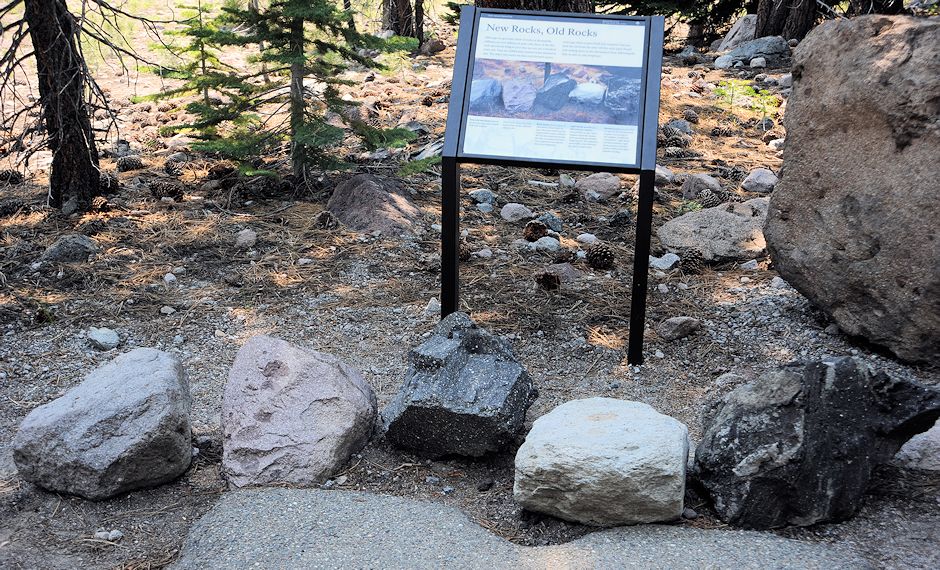
| Gray and red dacite formed 27,000 years ago when Lassen Peak first erupted. | They are the same rock type, Lassen Peak dacite, different only in color. | Black dacite (black to gray in coloration) formed May 14, 1915, when lava welled up into Lassen Peak's crater, sealing it off. The lava shattered during the May 19 eruption and lava rock fragments were carried here by an avalanche. | Light dacite pumice (lava filled with gas bubbles) formed May 22, 1915, when magma neared the surface and expanding gas bubbles fragmented it. The avalanche and mudflow that followed the blast carried it here. | Banded pumice, formed May 22, 1915, by the simultaneous eruption and mixing of two magmas of different composition -- light dacite and dark andesite. Light dacite pumice is banded pumice, without the dark andesite banding. |
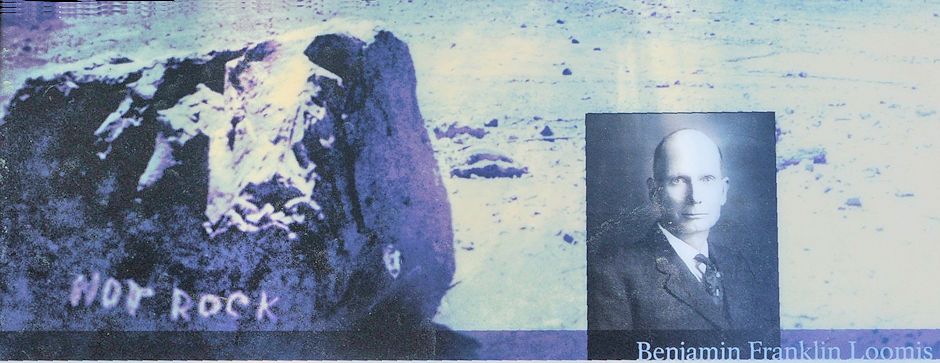
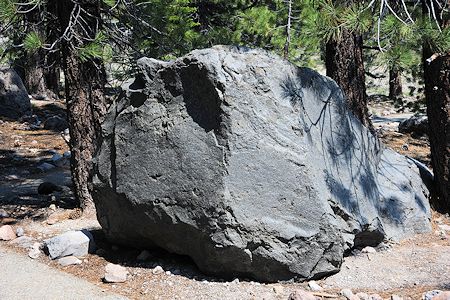
Hot Rock Many large rocks, some of them hot, were thrown from the crater, or torn off the lip of the crater on the west side, and carried down the creek by the raging torrents.
The rock shown here, shaded by these maturing trees, is the same rock labeled by B.F. Loomis in his Pictorial History of the Lassen Volcano, 1926.
The several-ton rock was hot to touch when Loomis photographed it three days after it was ejected from the crater of Lassen Peak as a new-glowing lava rock.
Businessman, amateur photographer, and author, B.F. Loomis began photo-chronicling Lassen Peak's eruptions in 1914.
His photographs brought national attention to the volcano and helped to bring about the establishment of Lassen Volcanic National Park.
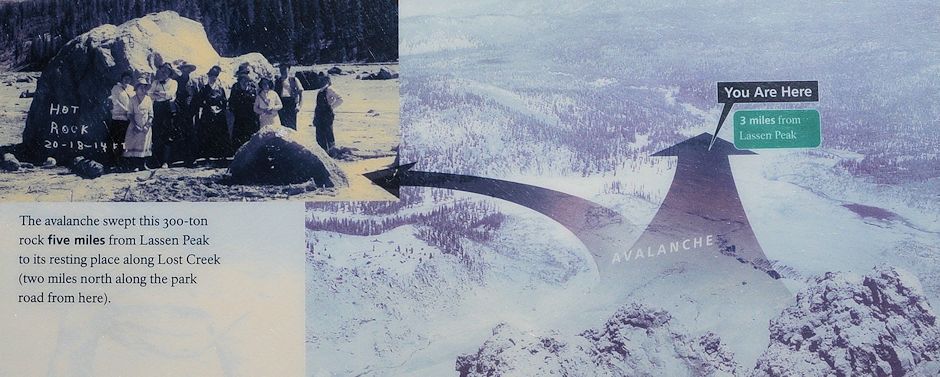
Rock and Roll The rocks and boulders resting here on the hillside were carried from Lassen Peak, three miles away. Many of the rocks are black dacite, pieces of the lava dome that plugged the volcano's crater, beginning May 14, 1915. Pressure from the pent-up gases within the volcano blasted and shattered the dome on May 19. Careening down the mountainside, the hot lava rocks set off a snow avalanche that tumbled, bounced, and carried the rocks to this location, where they settled, sizzled, and cooled.
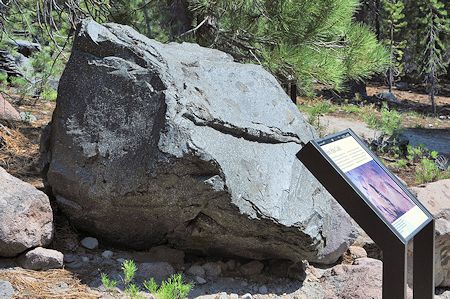
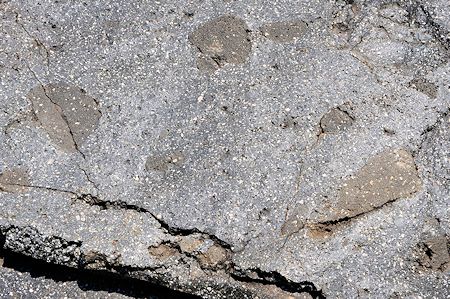
Hot Hits Cold Look closely at this 1915 black dacite boulder. Notice the patches contained within the rock.
These patches are called quenched blobs, formed during the rock's molten state. As molten rock, basalt magma mixed with dacite magma.
Dacite magma's temperature is much cooler than basalt's. When the hotter basalt injected into the cooler dacite magma, it was like hot wax hitting cold water.
The blobs were quenched --- cooled suddenly. When the lava oozed from the volcano's vent the blobs solidified and remained encased in the dacite rock.
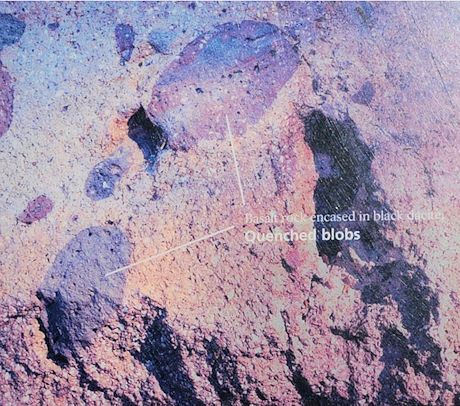
The mixing of the two magmas likely triggered the May 19 Lassen Peak eruption. When a superheated injection of basalt magma enters dacite magma, a volatile jolt occurs --- sometimes enough to cause a volcano to erupt.
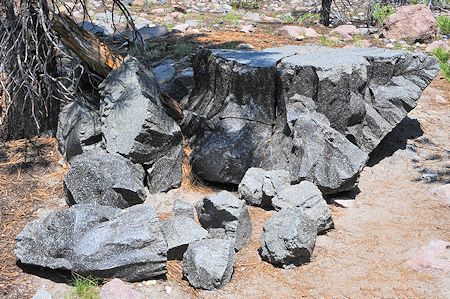
Puzzled Rocks After the May 19 avalanche carried hot lava rocks here, the surrounding air temperature rapidly cooled them.
As they cooled --- from the outside in --- some of the rocks fractured inwardly and radially like this one, breaking into pyramid-like shapes.
Like a jigsaw puzzle, many of the rock pieces you see here today could easily be reconfigured --- solving a hot puzzle of the past.
But why didn't all the rocks swept here by the avalanche fracture in this way?
Not all the rocks were hot.
Some were old rocks torn from Lassen Peak's summit. These rocks had already cooled some 27,000 years ago.
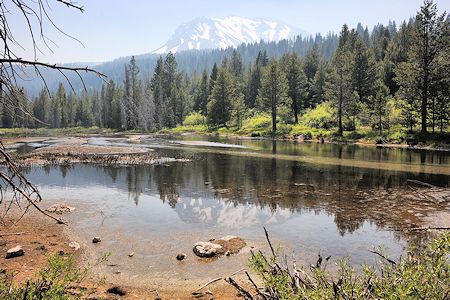
Lassen Peak over Hat Lake - haze from forest fires
From the interpretive exhibit I drove to Hat Lake.
Lassen Peak was somewhat obscured by the forest fire smoke.
Next stop was Summit Lake where we had started and ended the backpack trip in 1975.
On the way out of the parking lot, the gate was sticking out into the road and I didn't notice it as I was concentrating on a car that was entering .. and the pointed end of the gate, where they lock the two halves together, hit my passenger side mirror and tore it off.
Cost $174 to get it replaced when I got home.
Actually, I was fortunate that the gate hit the mirror instead of gouging a groove in the side of the car.

Summit Lake
From Summit Lake I proceeded to Helen Lake which sits in front of Lassen Peak. The lake still had ice floating in it and the smoke made the peak a bit hazy but the haze cleared up later.

Lake Helen and Lassen Peak
Bumpass Hell Nearby is the parking lot for the trail to Bumpass Hell. A three mile round-trip hike leads to the largest upward-flowing hydrothermal feature in the park. All of Lassen Volcanic National Park's hydrothermal features emanate from one heat source --- the same magma system that fed Lassen Peak's 1914-1921 eruptions.
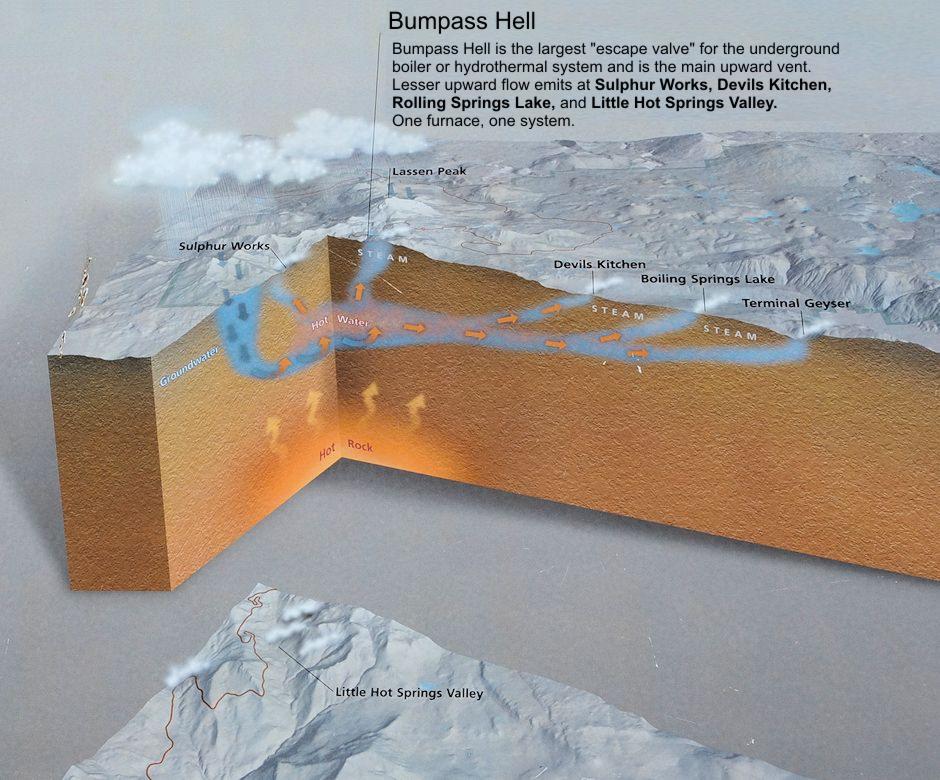
This moderate hike gradually climbs 270 feet within the first mile and then descends 245 feet into Bumpass Hell. There you can experience up close the workings of steam vents, mudpots, and boiling springs, which testify that volcanoes in the park are not dead, just resting.
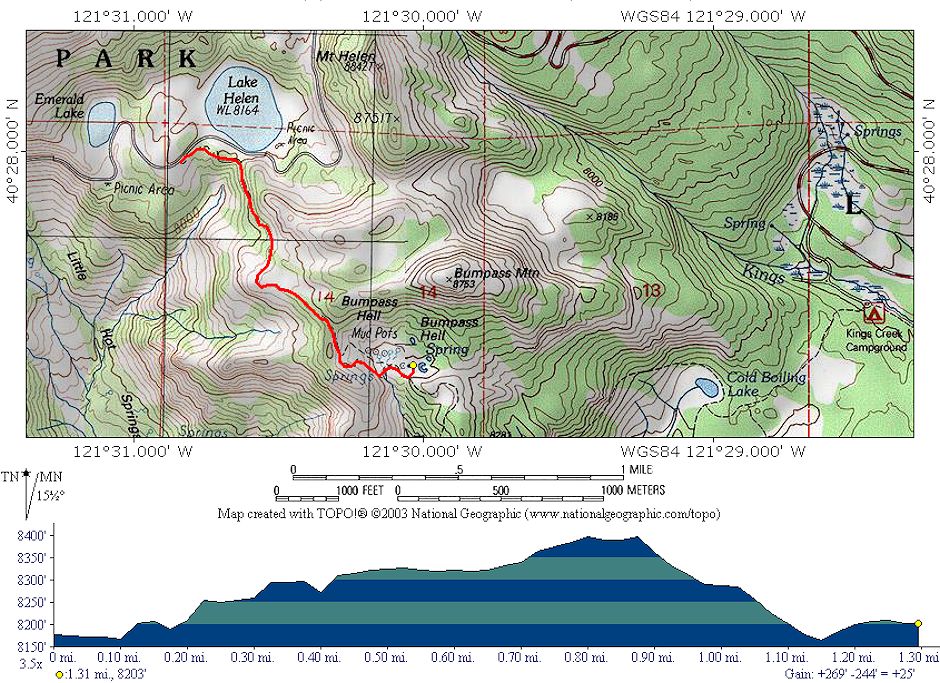
There was snow on the trail and I didn't have lug soled shoes so it was a bit slippery. I decided several times to just sit down and slide instead of risk falling.

There were a number of people on the trail. I arrived at Bumpass Hell in about an hour and walked the boardwalk taking pictures. I was the only one there as it was late in the day.
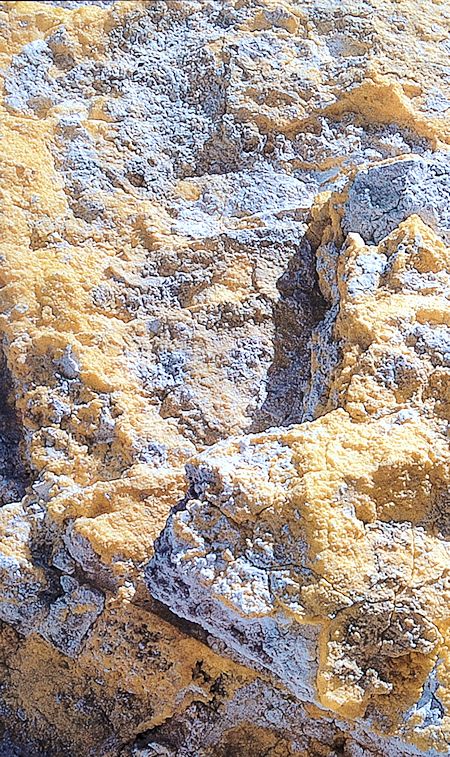
Sulfur Link The lava rock that once filled this area has been eaten away and altered into clay by sulfuric acid.
The acid can be linked to a high temperature form of sulfur (sulfur dioxide) released from the magma body that fires Bumpass Hell.
The rotten egg smell that fills the air can also be linked to sulfur.
It is hydrogen sulfide gas, a forerunner to the formation of sulfur --- yellow, pyramid shaped crystals that form on the ground here.
The white and orange yellowish ground crusts are also sulfur relatives, called sulfates.
Sulfate rich water evaporates at the surface, leaving the colorful sulfates behind.
The sulfates build up in ground crusts and change colors, depending on how wet or dry the crusts are.
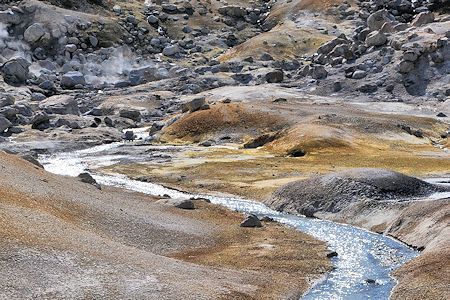
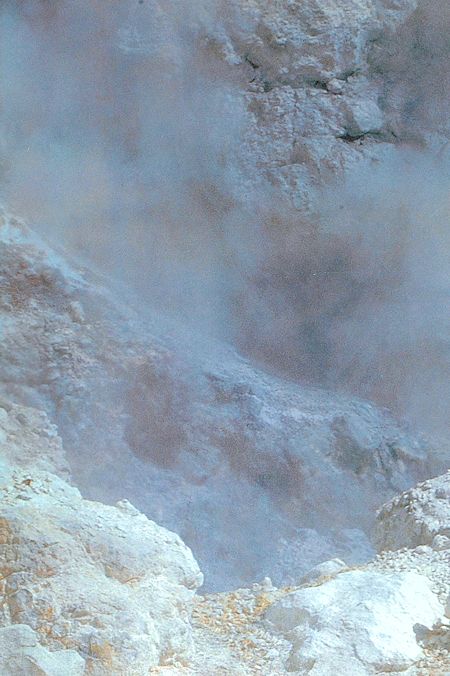
Big Boiler Big Boiler is the hottest fumarole --- within a non-erupting volcano --- in the world.
The steam temperatures measured here reach as high as 322°F (161°C). That's mighty hot.
But for perspective, flowing lava can reach 2,000°F (1,093°C) and the core of the Earth weights in at a mere 12,000°F (6,648°C).
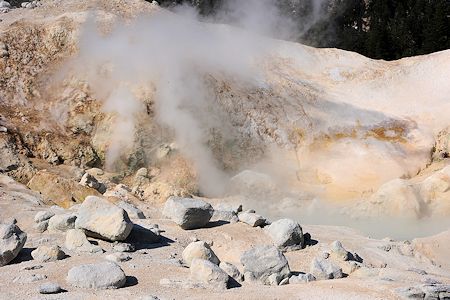
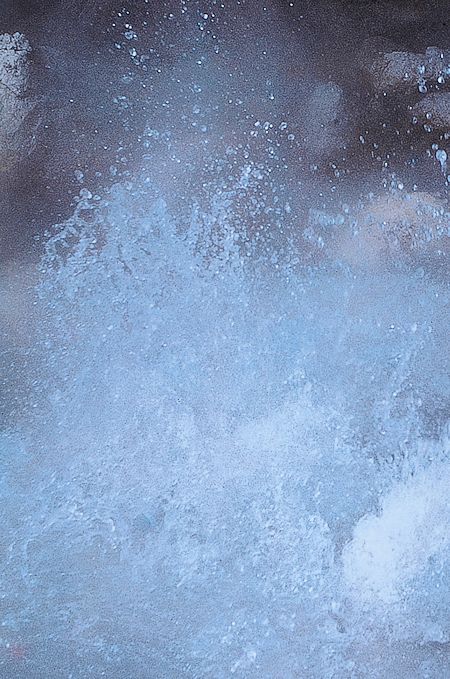
Boiling Pool Bumpass Hell occupies the old eroded vent of a dormant dome volcano --- Bumpass Mountain.
More than 75 fumaroles, hot springs, and mudpots compose this 16-acre hydrothermal area.
Hot spring water, far hotter than the boiling point, surges into and fills Boiling Pool.
At the surface, the acid sulfate water cools to the boiling point, and, amazingly, bacteria live in the boiling water.
The temperatures of each of the pools may vary. Which is all relative, of course, when "slightly cooler" means 150°F (66°C) instead of 200°F (93°C)!
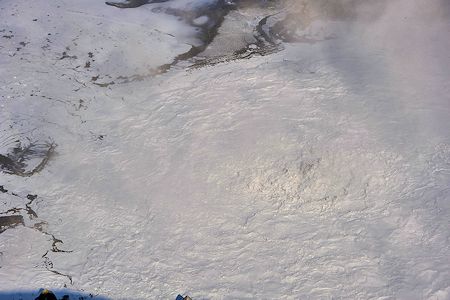
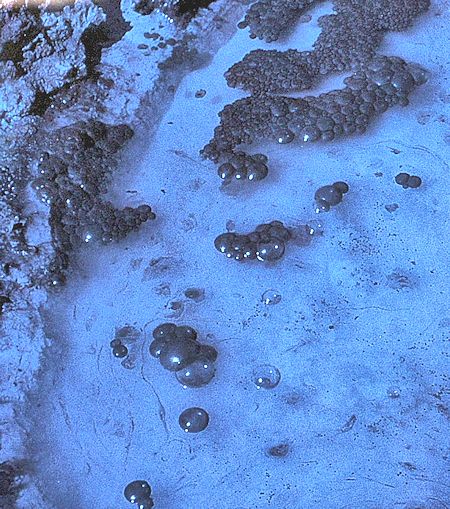
Pool "Fool" of Gold Do you see black scum on the surface of this pool? It's pyrite. The frothy mass contains tiny pyrite crystals, an iron-sulfide mineral that is perhaps better known as "Fools Gold." Iron leaches from rocks deep below and combines with sulfur as it rises through the hydrothermal system arriving at the surface as pyrite.
The stream emptying into East Pyrite Pool only slightly tempers the heat of this boiling pool. The upflow of Bumpass Hell's superheated steam is like a stove burner always on high.
Still, plant life finds favorable conditions to grow near the pool's edge. Bog-laurel and mountain heather are two common plants that grow in moist soils.
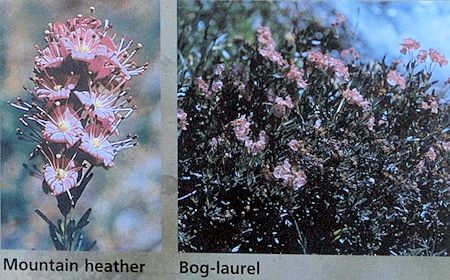
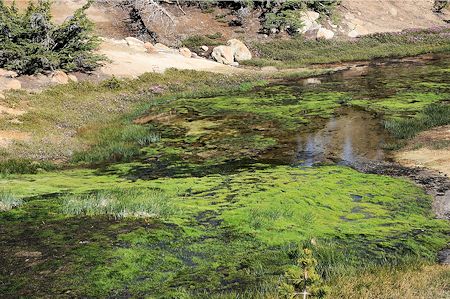
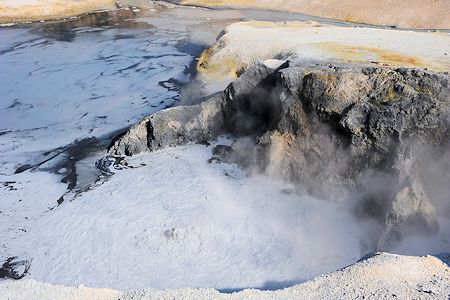
I slogged my way back up through snow out of Bumpass Hell and arrived back at the car in about an hour. The hike out offered a clear view of Lassen Peak over ice covered Lake Helen. I then headed for Susanville to spend the night before returning home the next day. The last stop was the Sulphur Works.
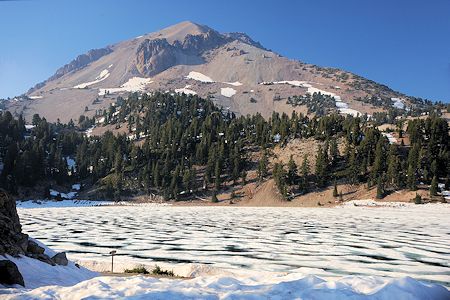
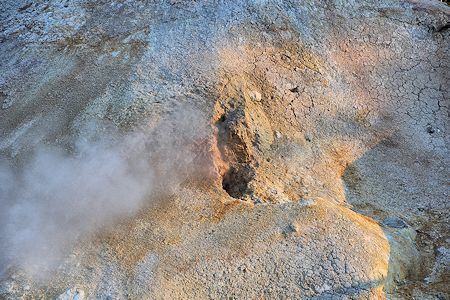
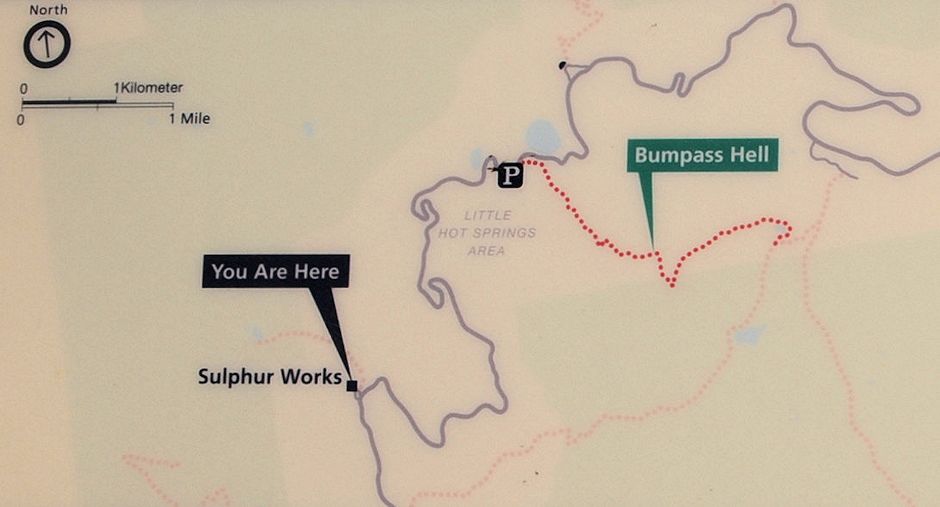
Connecting the Dots Using your imagination, you can connect the dots between the surrounding peaks of Brokeoff Mountain, Mount Conard, and Mount Diller, recreating the outline of an extinct composite volcano named Brokeoff Volcano, more commonly known as Mount Tehama.
It is worth trying to imagine, if only to comprehend its enormous size. The ancient volcano, active 600,000 to 400,000 years ago, measured 11 miles across and towered to 11,500 feet --- 1,000 feet taller than Lassen Peak.
Sulphur Works rests near the volcano's core. Although the volcano's fire is long extinguished, the hydrothermal system here at Sulphur Works is connected to the same magma system --- a network of magma pockets --- that fed the extinct volcano.
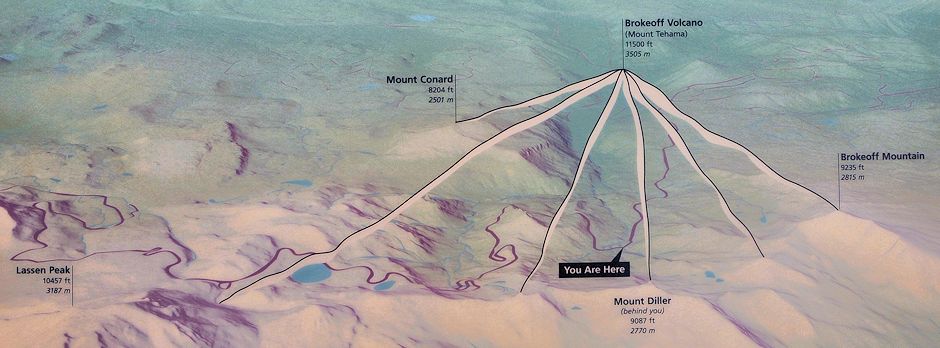

Lassen Peak from Devastated Area

Old Giant Rock Devastated Area Interpretive Trail

Hot Rocks - Devastated Area Interpretive Trail

Hat Lake
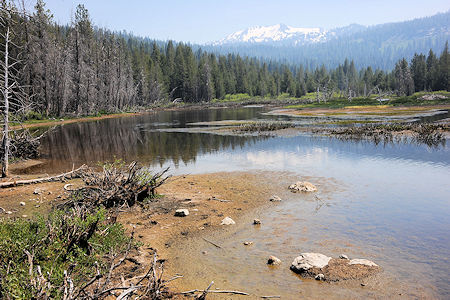
Hat Lake
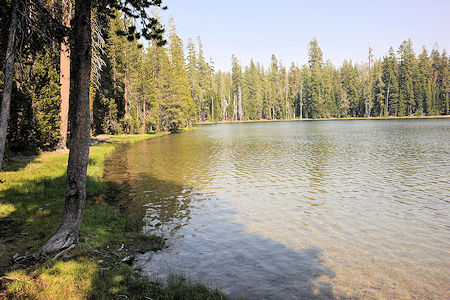
Summit Lake
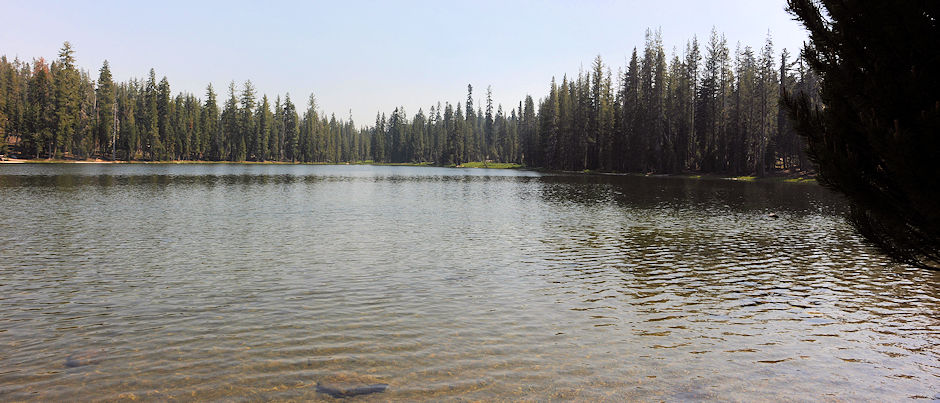
Summit Lake
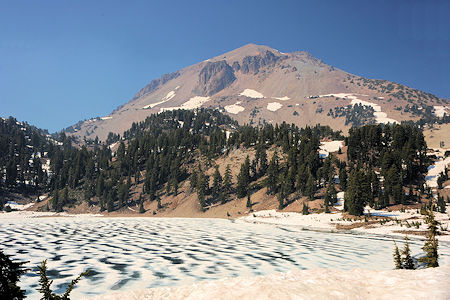
Lassen Peak behind ice covered Lake Helen
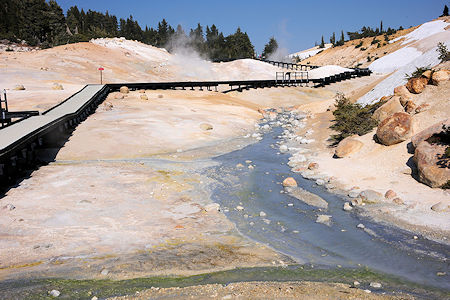
Bumpass Hell

Bumpass Hell
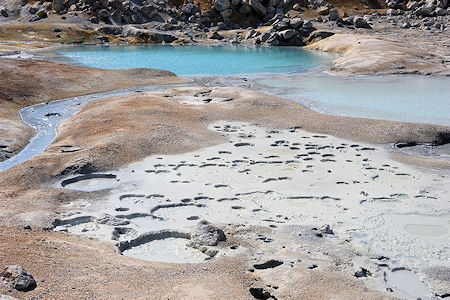
Bumpass Hell Mud Pots
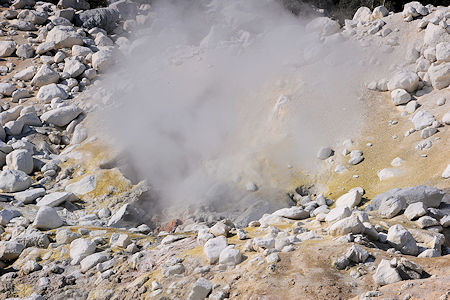
Bumpass Hell Fumarole

Bumpass Hell Big Boiler
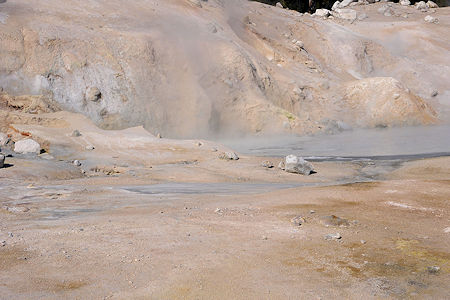
Bumpass Hell

Bumpass Hell Boiling Pool

Bumpass Hell

Bumpass Hell

Lassen Peak behind ice covered Lake Helen
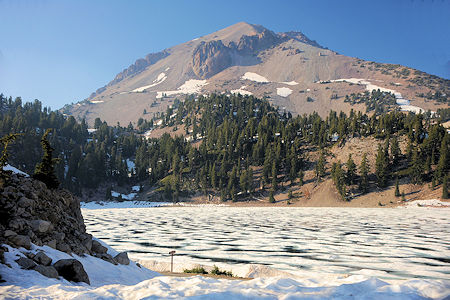
Lassen Peak behind ice covered Lake Helen
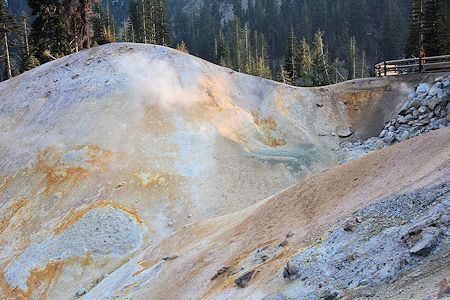
Sulphur Works - Sulphur Vent

Sulphur Works - Sulphur Vent